Rising Sea Levels To Endanger Nuclear Power Future
Commodities / Climate Change Jul 03, 2007 - 08:43 AM GMTBy: Bob_Kirtley
 One of the primary reasons for the building of more nuclear power plants today is to combat global warming and climate change, as nuclear power is relatively free of carbon emissions. However if this is to be used as a reason for building more plants, then this implies that the theory of global warming and its effects, such as sea levels rising are to be believed.
One of the primary reasons for the building of more nuclear power plants today is to combat global warming and climate change, as nuclear power is relatively free of carbon emissions. However if this is to be used as a reason for building more plants, then this implies that the theory of global warming and its effects, such as sea levels rising are to be believed.
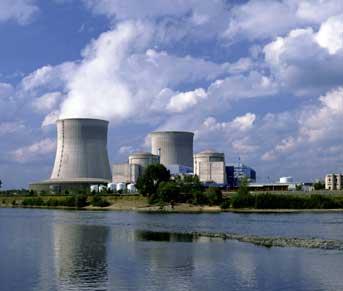
The most dramatic aspects that must be examined is the that fact the majority of nuclear power plants need a constant supply of large volumes of water and therefore many are next to large river, lakes and the biggest water source on earth, right next to the sea. And what's supposed to be happening to sea levels with global warming?
First, let us go into the science of why a nuclear plant needs a water supply. The reason is that the plants need water for cooling, and this applies not only to nuclear plants but to coal, oil and gas power plants as well. All these plants work in the same way, they produce electricity by heating up high quality steam and pushing in through a turbine, which turns the turbine, producing electricity. After it has turned the turbine, the steam must be turned back to water before it can be used to turn the turbine again, and so water is used to cool down the steam.
Therefore many nuclear power plants are situated near rivers, canals and a great majority are on the coast. Scientists predict that sea levels could rise over 20 feet, about 7m worldwide as the polar ice caps melt in the Arctic and Antarctica as well as glaciers melting such as the massive glaciers in Greenland . So if this hypothesis comes true, what will happen to all those nuclear plants on the coast?
As our main base of operations is in England , United Kingdom , we shall begin by analysing the position of British nuclear power stations. The UK has a total of 19 nuclear reactors providing approximately 19%-20% of its electricity. If we presume that we suffer the predicted sea level rise of 7 meters then we can model the effects of this on every area of the world using SRTM the topographic database of Earth provide by NASA.
In Hartlepool , which is in the North East of England, there are two AGR reactors with a capacity of 605 MWe. Hartlepool is on the coast of England and therefore suffers greatly when we model a 7m sea level rise as the satellite hybrid image below shows.
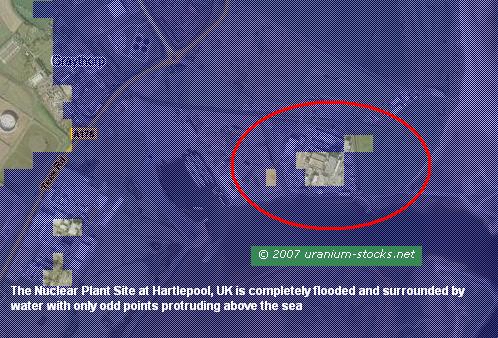
If we look further north to the Hunterson AGR reactors, which are situated near Glasgow , on the West coast of Scotland , we see further damage to nuclear plants caused by a rise in sea levels.
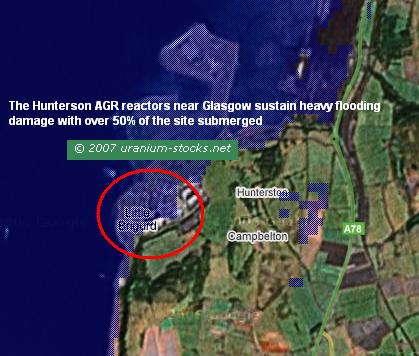
Over half of the Hunterson reactor site is underwater, which will put the plant out of action and take 595 MWe of power of the grid.
Although nearly all of the plants are suffering from heavy flooding damage, not all are totally submerged. The nuclear plant facility at Sizewell, on the east coast on England 's Midlands is still above sea level but the site is completely surrounded by sea and portions of the site are underwater.
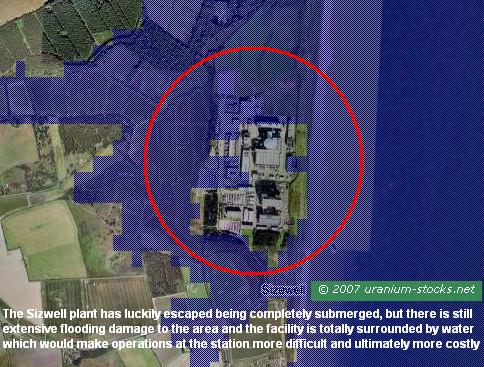
Not so lucky is the nuclear plants at Dungeness on the south coast of England .
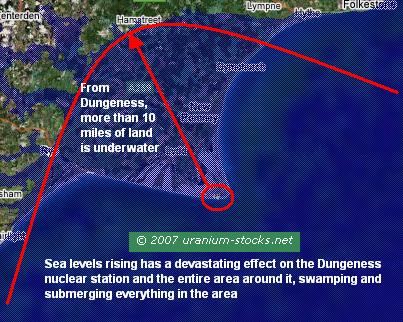
As the satellite images show, the entire area around the Dungeness nuclear site has been overrun by rising sea levels for more than 10 miles, an extreme amount of damage, destroying the Dungeness Nuclear Power Plant.
But it is not just the British nuclear installations that are going to suffer if sea levels rise. If we take a look across the Atlantic to the United States of America we also notice some damage to nuclear sites by sea level rises. The USA has the advantage that a fair number of its nuclear sites are many miles inland, on rivers, lakes and canals and as they are so far from the sea they escape the brunt of the damage. The majority of the nuclear power plants in the USA are deliberately difficult to locate on satellite imaging, for security reasons, such as the Hanford Site or codename “Site W” in Washington . This used to be a major base for the Manhattan Project and was used to provide plutonium necessary for the development of nuclear weapons. Now it is home to Columbia Generating Station and it is America 's most contaminated nuclear site. However, we have managed to locate some of the American plants at risk of flooding.
These plants are generally in states that have a large amount of coastline, such as California and Florida , where the sea is used as the water source to cool the plants. Florida is especially at risk, in out humble opinion, due to the fact that the area is prone to hurricanes and severe tropical storms that could really damage nuclear sites on the coast especially when combined with a rise in sea levels of over twenty feet.
So let us take a look at Florida 's nuclear plants and what would happen to them with a rise in sea levels of 7m.
First up, on Florida 's west coast is the Crystal River nuclear site. Compared with other nuclear plants, Crystal River isn't too badly affected.
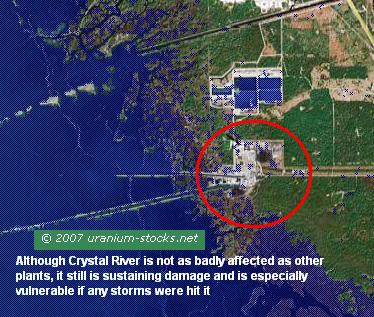
However it is still suffering from flood damage and it would only take one severe hurricane to flood the entire plant and devastate the Crystal River nuclear facility.
Now if we switch to the other side of Florida , the East coast, we find the St Lucie nuclear power plant, delicately positioned on a thin strip of land surrounded by the ocean.
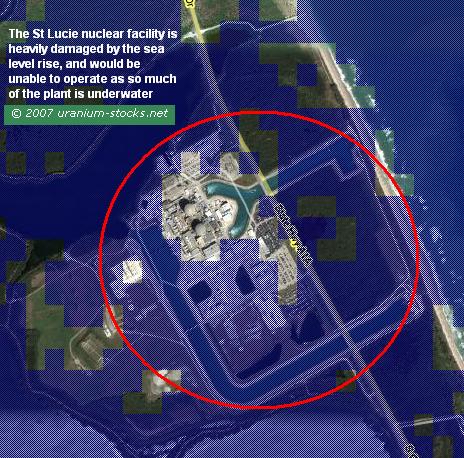
As you can see from the satellite image above, this nuclear plant is in a much worse position than Crystal River with much of St Lucie underwater leaving the much of the plant destroyed and the facility inoperable.
Looking further south, there is a nuclear power plant at Turkey Point in Southern Florida .
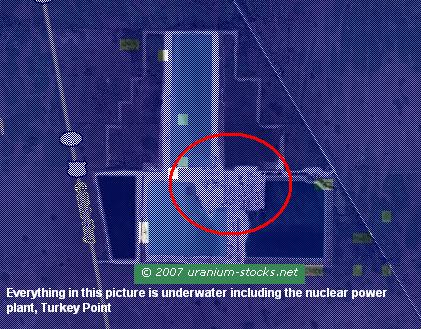
Turkey Point is completely underwater, leaving the nuclear power station totally destroyed. In fact nearly all of southern Florida is submerged as the image below demonstrates.
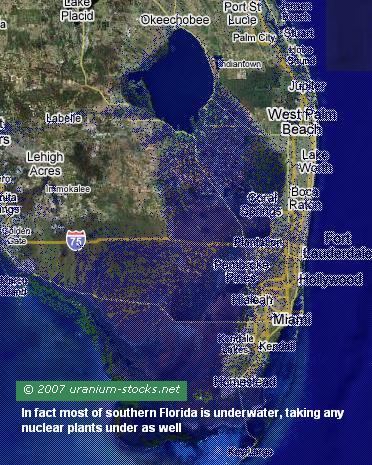
Even the world leader in nuclear power does not escape this disaster unscathed. France gets almost 80% of its electricity from nuclear power but even its nuclear power stations are taking heavy damage. For example the plant at Penly, Saint-Martin-en-Campagne, Seine-Maritime , France , is shown below with a 7m rise in sea level.
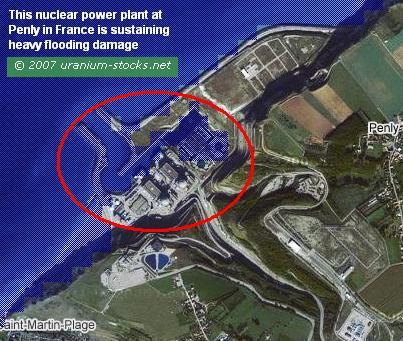
As you can see, much of the site and nearly the entire harbour wall, which crucially protects the plant from storms and extreme waves and weather conditions, are submerged.
Taking a look at other areas of the world, we jump to Brazil and see the damage done to its PWR nuclear reactor at Angra, which could suffer heavy flooding.
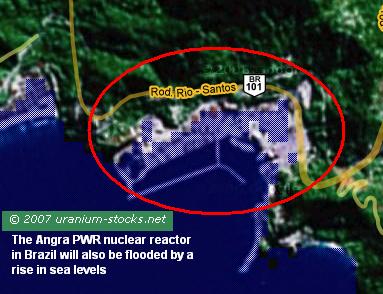
South Africa's one and only nuclear station providing a net output of 920 MWe from a PWR is damaged as sea comes to the edge of the plant at Melkbosstrand, and it only takes one storm to severely damage the plant and when storms become more and more frequent and more and more severe this heightens the risk of serious damage.
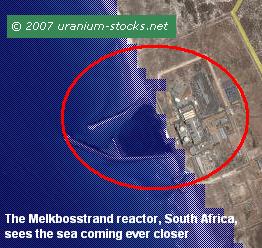
In the east, India nuclear plants may also be at risk such as the Tarapur BWR in Maharashtra , which appears to be totally underwater after a rise of 7m in sea levels.
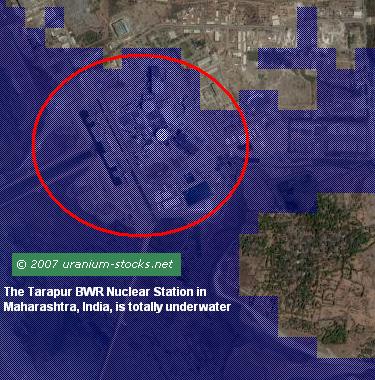
I hope by now you too are realising the risk that rising sea levels causes to the world. It is not just about a few beach houses being lost; there is a serious possibility that a large number of nuclear plants could become flooded. It is bad enough that they will become inoperable, but what is a greater danger is that the plants could be destroyed or seriously damaged in a storm and could leak radioactive waste into the sea and surroundings or at worse somehow accidentally have a nuclear meltdown.
This would be a devastating environmental, political, economical and most importantly humanitarian crisis.
So, do we still support nuclear power?
Absolutely. In fact we should support nuclear power even more. The world needs to change to nuclear power for numerous fundamental reasons, which we have covered in previous articles . This above content should not discourage the building of new plants, but accelerate the process of beginning to plan, design and build the stations. We, the world, are going to build more nuclear plants, that is a given. We need to start now in order to allow enough time to properly plan the stations and their location so we can take into account all the factors affecting the success of a plant, such as protection from rising sea levels.
If we do not start planning and building the plants now, then we may be forced to rush the building in years to come, meaning they may be built in such a way or in such a place that the risk of an accident is dramatically increased.
All of this is bullish for uranium and uranium stocks in the short term and the long term, as it means that governments should begin building sooner and before they open a plant they need 2 – 3 years of uranium and so therefore they will need to buy uranium sooner, before the uranium supply is bought for the next century or hoarded by the smarter players in the game.
For ideas on which uranium stocks to invest in, subscribe to the uranium stocks newsletter at www.uranium-stocks.net completely free of charge.
By Bob Kirtley
www.uranium-stocks.net
Bob Kirtley spent many years working on Oil projects including some in Alberta, such as the tar sands installations in Fort McMurray. He lived and worked in many different countries, as that is the nature of the construction business. Planning and cost control are key to a projects success and he tries to apply those disciplines on a daily basis when dealing with investments. His training in such areas as SWOT and Risk analysis can be applied from time to time. His qualifications include being chartered in the United Kingdom, which is similar to that of a Professional Engineer in Canada, along with a Masters Degree in Project Management from South Bank University, London, England.
He has been working for a number of years on a full time basis representing a group of investors in England.
DISCLAIMER : Silver Prices makes no guarantee or warranty on the accuracy or completeness of the data provided on this site. Nothing contained herein is intended or shall be deemed to be investment advice, implied or otherwise. This website represents our views and nothing more than that. Always consult your registered advisor to assist you with your investments. We accept no liability for any loss arising from the use of the data contained on this website. We may or may not hold a position in these securities at any given time and reserve the right to buy and sell as we think fit.
Bob Kirtley Archive |
© 2005-2022 http://www.MarketOracle.co.uk - The Market Oracle is a FREE Daily Financial Markets Analysis & Forecasting online publication.
Comments
|
jerome
16 Sep 10, 00:28 |
science
me i ask the manager for the power plant what gives the good support of the world |


